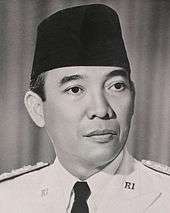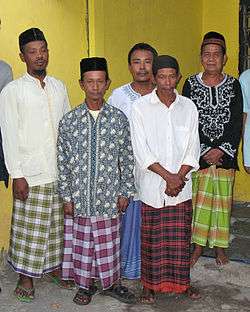National costume of Indonesia

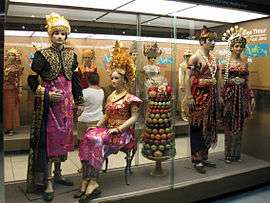
The National costume of Indonesia are the national costume that represent the Republic of Indonesia. It is derived from Indonesian culture and Indonesian traditional textile traditions. Today the most widely recognize Indonesian national costume are Batik[1] and Kebaya, although originally those costumes mainly belong within the culture of Java and Bali, most prominently within Javanese, Sundanese and Balinese culture.[2] Since Java has been the political and population center of Indonesia, folk costume from the island has become elevated into national status.
As a multi-diverse country, Indonesia having more than 30 provinces, each has its own representation of traditional attire and dress from each province with its own unique and distinguished designs.
National costumes are worn during official occasions as well as traditional ceremonies. The most obvious display of Indonesian national costumes can be seen by the type of costumes worn by the President of Indonesia and the Indonesian first lady in many and different types of occasions and settings, and also worn by Indonesian diplomatic officials during gala dinners. Traditional weddings and formal ceremonies in Indonesia are also one of the important occasions in the country where the attire of the national costume of Indonesia is absolutely visible ranging from traditional to modern attire different from each region it is representing.
National costumes
Batik

Batik is a cloth that is traditionally made using a manual wax-resist dyeing technique to form intricate patterns. Traditionally batik cloth is a large piece of intricately decorated cloth used by Javanese women as kemben or torso wrap. Batik cloth were wrapped around the hips with multiple folds in front called wiron, while the upper torso wear kebaya fitted dress. Traditionally for men, the edge of batik cloth also can be sewn together to make a tubular cloth as sarong, or wrapped around hips as kain in fashion similar to women's. Later for men, the batik cloth also sewn and made into contemporary batik men's shirt.
Batik is recognized as one of the important identity of Indonesian culture. UNESCO designated Indonesian batik as a Masterpiece of Oral and Intangible Heritage of Humanity on October 2, 2009. As part of the acknowledgment, UNESCO insisted that Indonesia preserve their heritage.[3]
Batik shirts, which are commonly worn by men in Indonesia (especially in Java), are usually worn during formal occasions; such as attending weddings, traditional ceremonies, formal meetings, communal gatherings, etc. Sometimes men who wear batik shirt usually also wearing a songkok or peci cap to make it more formal in a traditional way. Batik shirts has two types of cuts; long sleeves for formal occasions, and short sleeves for casual to semi-formal occasions. Batik shirt or blouse are also available for women. Batik pattern differs from region to region, especially across Java and other islands, which has their own motifs or patterns unique to their respective local tradition and culture.
Kebaya
The kebaya is the national costume of women from Indonesia, although it is more accurately endemic to the Javanese, Sundanese and Balinese peoples.[2] It is sometimes made from sheer material such as silk, thin cotton or semi-transparent nylon or polyester, adorned with brocade or floral pattern embroidery. Kebaya usually worn with a sarong or batik kain panjang, or other traditional woven garment such as ikat, songket with a colorful motif.
The earliest form of kebaya originates in the court of the Javanese Majapahit Kingdom as a means to blend the existing female Kemban, torso wrap of the aristocratic women to be more modest and acceptable to the newly adopted Islam religion. Aceh, Riau and Johor kingdoms and Northern Sumatra adopted the Javanese style kebaya as a means of social expression of status with the more alus or refined Javanese overlords.[4]
Kebaya is usually worn during official national events by Indonesian first lady, wives of Indonesian diplomats, and Indonesian ladies. It also worn by Indonesian ladies attending traditional ceremonies and weddings. In Kartini day on 21 April Indonesian women usually wear kebaya to celebrate and honor the Indonesian women emancipation heroine. During Balinese traditional ceremonies, Balinese women wore colorful Balinese style kebaya with songket Bali.
Peci
Peci, also known as songkok or kopiah, are traditionally male Muslim's cap in Indonesian archipelago. It is quite similar to Turkish-Egyptian fez. In Indonesia, the black velvet peci has become the national headdress with secular nationalist connotations made popular by Sukarno.[5] Numbers of Indonesian nationalist movement activist in early 20th century, such as Sukarno, Muhammad Hatta and Agus Salim, wore peci to convey their nationalistic sentiments and to demonstrate their Indonesian identity. Indonesian male presidents always wear peci as part of their official presidential attire.
Since then, the black velvet peci is approved to be the national head-dress for Indonesian men. It is worn all over Indonesia, especially by government officials and men (usually Muslim men) throughout the country. The peci is usually worn with batik shirt or western-style suites by men in Indonesia for those attending formal occasions. It is also commonly worn during Islamic religious occasions. Senior citizen Muslim men across Indonesia — usually in Jakarta who identify themselves as native Betawi people, also use this peci in an everyday basis. It is also a traditional head-dress of the Betawi people and also other ethnic groups, especially in the western parts of Indonesia which are mainly Muslims.
Regional costumes
Other than national costumes, each of the provinces of Indonesia — more precisely every ethnic groups of Indonesia, have their own regional traditional costumes. These regional costumes in Indonesian is called baju adat or pakaian adat, and derived from traditional Indonesian textile traditions and crafts. The best chance to see an example of Indonesian traditional costumes is by attending a traditional wedding ceremony. The traditional costumes differs according to its function and occasion; the most elaborate and extravagant ones usually reserved for bride and groom only, while a more common traditional costumes are worn by local people during traditional ceremonies. Some examples of Indonesian regional costumes (baju adat) are:


 Malay modern Muslim
Malay modern Muslim
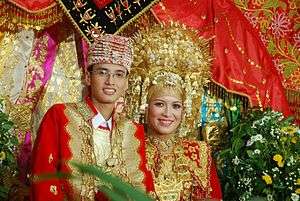
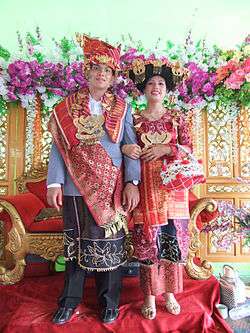


Textiles
Stamped batik, the design of which takes months to create; double weave ikat from the islands of Nusa Tenggara, silk Bugis sarong from Sulawesi, gold-painted Balinese prada fabric; shimmering kain songket from Palembang utilizing silver and gold metallic threads weft in woven cotton or silk ikat; and tapis weavings from Lampung. Weavings from the 34 provinces utilize different materials, methods, colors and designs. Primarily formed on back looms, weeks or months are spent creating intricate designs for everyday use or ceremonial wear. These weavings are primarily known by the different techniques that are used to create the distinctive designs.
The symbolism of the various ethnic groups is evident in the variety of textiles. Color, shapes and their arrangements all have special meanings. Certain designs can only be worn by women or men, or only by the members of the royal family or nobility. Special textiles are worn or exchanged in life cycle or rights of passage ceremonies celebrating birth, circumcision, puberty, marriage, childbearing and death. Textiles play an important role in many traditional events and ceremonies.
Written records dating to the fourteenth century document the importance of textiles in the social and religious lives of Indonesians. The highly distinctive traditional dress, or pakaian adat, best shows the diversity of uses of textiles throughout the archipelago. The even more elaborate bridal dress displays the best of each province's textile and ornamental jewelry traditions.
- Sarong is the most popular waist worn garment in Indonesia mainly worn by men. It is popular among Muslim men across Indonesia and also by other regions and tribes throughout the country. It is mainly worn in Java, Bali, Sumatra, Kalimantan, and other places. It is very similar to the Indian Lungi.
- Songket, a hand-woven in silk or cotton, and intricately patterned with gold or silver threads. In Indonesia, songket is more prevalent in Sumatra and Lesser Sunda Islands (Bali, Lombok and Sumbawa), while in Java, batik is more popular. Various songket patterns are traditionally produced in Sumatra, Kalimantan, Bali, Sulawesi, Lombok and Sumbawa. In Sumatra the famous songket production centers is in Minangkabau Pandai Sikek area, West Sumatra,[6] Jambi City. Jambi and Palembang, South Sumatra. In Bali, songket production villages can be found in Klungkung regency, especially at Sidemen and Gelgel village.[7] While in the neighboring island of Lombok, the Sukarara village in Jonggat district, Central Lombok regency, is famous for songket making.[8]
- Ikat, a dyeing technique used to pattern textiles that employs a resist dyeing process on the yarns prior to dyeing and weaving the fabric. In Indonesia it is more prevalent in Lesser Sunda Islands, especially in Bali, Sumba, Flores and Timor islands. It is also can be found in Sumatra, Borneo and Sulawesi among Batak, Dayak and Toraja tribes.
- Ulos, a traditionally hand-woven cotton fabrics, and intricately patterned, specific to Batak tribes of North Sumatra usually slung over the shoulder during traditional occasions.
- Tapis, a traditionally hand-woven fabrics, specific to Lampung province on southern part of Sumatra.
- Tenun, is actually a generic Indonesian term for "woven". It encompass wide variations of Indonesian traditional hand woven textiles.
Clothing
In Indonesian archipelago, the most basic and traditional way to wear a traditional garments, is just by wraping the traditional fabrics around the hips as kain or sarong and secure it; and for women, wrapping the torso with kemben (torso wrap). This practice can still be found in Java, Bali, and Nusa Tenggara. Nevertheles the development and the expansion of sewing and clothing techniques has creates tailored shirts for men and women. Tight fitting women's kebaya and tailored batik shirt for men is the example of traditional clothing that today transcends ethnic boundaries in Indonesia and has become a national costume. Other than those two, there are numbers of tailored clothings or shirt developed in Indonesia.
- Baju koko also known as baju takwa, a traditional Malay-Indonesian men Muslim shirt, worn usually during religious occasions, such as shalat jumat or during lebaran (Eid al-Fitr) festival. It is usually worn with the sarong and peci.
- Beskap, Javanese traditional clothing worn usually by men for formal traditional attire
- Baju kurung, Malay women's blouse.
- Baju bodo, Bugis-Makassar women's loose and rather transparent blouse, from South Sulawesi.
Headgear
Each different region, island, tribe, and culture in Indonesia has its own head-dress/head-gear worn traditionally by the particular people of the area. The peci or songkok is the national formal head-dress worn by men all over Indonesia, usually worn by government officials. Men's head-dress are usually made of traditional fabrics, while women's head-dress often are consists of metal jewelries sometimes decorated with floral arrangements. Examples of different head-dress across the country are:
Men
 A boy wearing the Balinese udeng
A boy wearing the Balinese udeng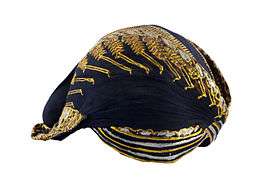 A Javanese Yogyakartan blangkon
A Javanese Yogyakartan blangkon An Acehnese kupiah meukeutob
An Acehnese kupiah meukeutob A Bugis-style songkok from Bima
A Bugis-style songkok from Bima A Dayak feathered hat beluko
A Dayak feathered hat beluko- A Malay tanjak
- Blangkon, Javanese men's headgear.
- Iket, Sundanese men's headgear.
- Kupiah, Acehnese men's headgear.
- Tanjak, Malay men's headgear.
- Udeng, Balinese men's headgear.
- Beluko, Dayak feathered hat, there are different version for men and women
Women
 A woman wears Minang tengkuluk tanduk horned head-dress
A woman wears Minang tengkuluk tanduk horned head-dress Cunduk mentul or kembang goyang hair ornament
Cunduk mentul or kembang goyang hair ornament A traditional Indonesian women head-dress; jamang or siger crown and kembang goyang
A traditional Indonesian women head-dress; jamang or siger crown and kembang goyang- A Minang suntiang, gilded crown for bride
 A Palembang-style siger, singkar sukun pa sangko, gilded crown for bride or dancer
A Palembang-style siger, singkar sukun pa sangko, gilded crown for bride or dancer A traditional Lampung siger headgear
A traditional Lampung siger headgear
- Konde or sanggul, originally refer to a type of hairdo. Today, it refer to hairbun extension, attached to the back of the head. Commonly worn by women in Java and Bali as a part of their kain kebaya costume. The hairbuns are usually made from natural human hair. Konde is usually secured with tusuk konde hairpin, and adorned with jasmine flower garland or other hair ornaments.
- Kembang goyang (lit.: "trembling flower") or cunduk mentul, a golden flower ornament attached to the hairbun. Similar metallic floral hair ornaments can be found throughout Indonesia, however it is more prevalent in Java and Bali.
- Jamang, a gilded tiara-like crown, worn around the forehead to the side of the head. It was derived from Hindu-Buddhist heritage, now still worn in Javanese and Balinese wayang orang performance, Javanese srimpi dancers, and Sundanese bride headgear.
- Siger, a large horned and gilded Lampung women's headgear. Today, usually made of brass. In Palembang, a smaller similar version is known as singkar.
- Suntiang, a tall, large and rather heavy Minang gilded crown for the bride. Traditionally made from gold, today however, usually made from brass.
- Tengkuluk tanduk, a horned head-dress made from folded traditional fabrics (usually songket), unique to Minang culture, especially Bundo Kanduang costume.
- Kerudung, a traditional Muslim women's veil of loosely worn cloth over the head. Unlike completely covered jilbab, parts of hairs and neck are still visible.
- Jilbab, a more conservative generic Muslim women's veil, adopted from Middle Eastern style. Usually worn by more conservative Muslim women. Unlike kerudung, hair and neck are completely covered.
See also
- Culture of Indonesia
- Folk costume
- Rumah adat
- Native Indonesian
- Etiquette in Indonesia
- Indonesian cuisine
References
- ↑ Xia Ziyi (2011-11-16). "Cultural feast at ASEAN Fair". Xinhua. Retrieved 28 March 2012.
- 1 2 Jill Forshee, Culture and customs of Indonesia, Greenwood Publishing Group: 2006: ISBN 0313333394. 237 pages
- ↑ Indonesian Batik Inscribed in 2009 on the Representative List of the Intangible Cultural Heritage of Humanity
- ↑ Maenmas Chavalit, Maneepin Phromsuthirak: Costumes in ASEAN: ASEAN Committee on Culture and Information: 2000: ISBN 974-7102-83-8. 293 pages
- ↑ Yusep Hendarsyah (28 April 2011). "Peci Hitam dan Identitas Paling Indonesia". Kompasiana. Retrieved 28 March 2012.
- ↑ Tenun Songket Pandai Sikek (Sumatera Barat - Indonesia)
- ↑ Kartika Suardana. "Songket Bali, Busana dan Aksesori Nusantara". National Geographic Traveller Indonesia (in Indonesian) (Vol 1, No 6, 2009 ed.). Jakarta, Indonesia. p. 62.
- ↑ Manggalani L Ukirsari. "Songket Lombok, Busana dan Aksesori Nusantara". National Geographic Traveller Indonesia (in Indonesian) (Vol 1, No 6, 2009 ed.). Jakarta, Indonesia. p. 62.

